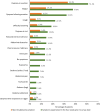Clinical characteristics, treatment patterns and healthcare resource utilisation for portopulmonary hypertension patients in the USA: a real-world study
- PMID: 40537224
- PMCID: PMC12182033
- DOI: 10.1136/bmjopen-2024-089223
Clinical characteristics, treatment patterns and healthcare resource utilisation for portopulmonary hypertension patients in the USA: a real-world study
Abstract
Objectives: To investigate demographic, clinical characteristics, treatment patterns and healthcare resource utilisation (HCRU) among patients with portopulmonary hypertension (PoPH).
Design: Retrospective analysis of a real-world cross-sectional survey, the pulmonary arterial hypertension (PAH) Disease Specific Programme.
Setting: Secondary care settings in the USA.
Participants: Pulmonologists (n=22), cardiologists (n=17) and internists (n=7) who saw ≥2 patients with PAH/month provided data on 90 PoPH patients. Mean age of patients was 56.8 years, 51.1% were male, 76.7% were white/Caucasian.
Primary and secondary outcome measures: Demographic characteristics, initial presentation/diagnosis, disease trajectory, symptoms, comorbidities, treatment patterns and HCRU.
Results: The most common diagnostic tests were echocardiogram (62.2%), right heart catheterisation (56.7%) and electrocardiogram (48.9%). Dyspnea on exertion (64.4%), dyspnea following exertion (51.1%) and fatigue (48.9%) were the most common symptoms prior to PAH diagnosis as well as the most bothersome. Overall, 13.3% patients had mild disease before treatment vs 42.2% at time of survey. Most (60.0%) had stable disease (21.1% were improving and 18.8% were deteriorating at the time of the survey). Most common recent symptoms were dyspnea on exertion (51.1%), fatigue (37.8%) and dyspnea following exertion (32.2%). Patients had a mean of 1.8 comorbidities. In total, 80.0% of PoPH patients were receiving PAH-specific treatment; 41.7%, 22.2% and 12.5% received monotherapy, dual therapy and triple therapy, respectively. Patients had seen their physician 4.1 times in the past 12 months (3.5 visits specifically for PAH), while 31.1% had been hospitalised for PAH. Most (70.0%) patients were managed in a multidisciplinary team, and 8.9% of patients relied on a caregiver.
Conclusions: This study highlights the high symptomatic burden coupled with mostly moderate-to-severe disease status and a high hospitalisation rate despite the majority of PoPH patients being on therapy. Therefore, new treatment options in PoPH are in great need.
Keywords: Patient Care Management; Patients; Pulmonary Disease.
© Author(s) (or their employer(s)) 2025. Re-use permitted under CC BY-NC. No commercial re-use. See rights and permissions. Published by BMJ Group.
Conflict of interest statement
Competing interests: HD received consulting fees from Janssen; MSm, MSc and JH are employees of Adelphi Real World, an agency that received funding from Janssen to undertake this study; PA, YT and SP are former employees of Janssen.
Figures




Similar articles
-
Signs and symptoms to determine if a patient presenting in primary care or hospital outpatient settings has COVID-19.Cochrane Database Syst Rev. 2022 May 20;5(5):CD013665. doi: 10.1002/14651858.CD013665.pub3. Cochrane Database Syst Rev. 2022. PMID: 35593186 Free PMC article.
-
Burden of disease and treatment patterns in patients with vitiligo: findings from a national longitudinal retrospective study in the UK.Br J Dermatol. 2024 Jul 16;191(2):216-224. doi: 10.1093/bjd/ljae133. Br J Dermatol. 2024. PMID: 38534198
-
Macitentan and Tadalafil Combination Therapy in Patients with Pulmonary Arterial Hypertension and Cardiovascular Comorbidities: Real-World Evidence from OPUS and OrPHeUS.Adv Ther. 2025 Jul;42(7):3306-3333. doi: 10.1007/s12325-025-03180-0. Epub 2025 May 19. Adv Ther. 2025. PMID: 40388087 Free PMC article.
-
Home treatment for mental health problems: a systematic review.Health Technol Assess. 2001;5(15):1-139. doi: 10.3310/hta5150. Health Technol Assess. 2001. PMID: 11532236
-
Clinical Characteristics and Treatment of Patients Diagnosed with Pulmonary Arterial Hypertension: A Real-World Study in the USA, Europe and Japan.Adv Ther. 2025 Jan;42(1):193-215. doi: 10.1007/s12325-024-03026-1. Epub 2024 Nov 4. Adv Ther. 2025. PMID: 39495236 Free PMC article.
References
MeSH terms
LinkOut - more resources
Full Text Sources
Medical
Miscellaneous
